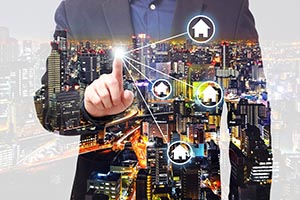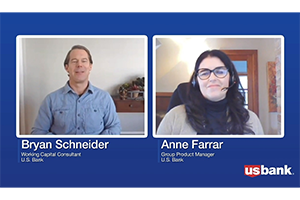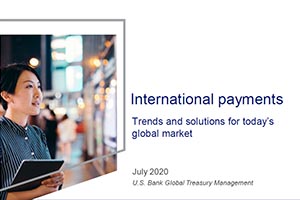The Government Consumer Payments Insight Report offers an assessment of opportunities to improve and innovate the payment experience to better align with the rapidly evolving expectations of today’s citizens.
By Joe Myers President of North America at U.S. Bank Payment Solutions/Elavon Inc.
 COVID-19 has been described as the “Big Bang” for the digital transformation of how we work, learn and play. Everything from shopping and entertainment, to learning and healthcare, and how we interact and communicate with our friends and co-workers in social and business settings has changed. And there is no going back.
COVID-19 has been described as the “Big Bang” for the digital transformation of how we work, learn and play. Everything from shopping and entertainment, to learning and healthcare, and how we interact and communicate with our friends and co-workers in social and business settings has changed. And there is no going back.
The jolt from the pandemic was felt throughout businesses, schools, and government agencies. It also became the catalyst for adopting modern payment methods as lockdowns, social distancing, and fear of contracting the virus forced consumers to seek alternative ways to pay. As a result, market growth projections for digital payments have been revised upward by almost 14% from initial forecasts for the period from 2021 to 2026.
The results from our 2021 Government Insights Payments Report underscore the enormous impact of the pandemic on the government payments landscape.
Governments catching up with a modern payment experience
The good news is that consumers noticed – and appreciated – the efforts of government agencies to adopt new payment acceptance methods. Fifty-six percent of respondents told us the government is keeping pace with payment innovation in other industries. This is up a full 10% over the results of our 2020 survey.
With many government offices closed, and staff working from home, the need to send bills via electronic means became a necessity. Local and state municipalities, agencies and utilities quickly instituted digital delivery. Sixty percent of participants reported receiving at least one email notification, up 33% over last year. Notifications via text and mobile app also increased 21% and 17% respectively.
When asked which payment methods this year’s participants have used to pay government-related fees and bills, participants gravitated to those which allow bills to be paid via phone or digitally – online, mobile, email, or text – versus in person and by mail. While the rise in the usage of digital payment methods is not a surprise considering lockdowns and social distancing measures, it is evident that they will continue to be preferred methods going forward.
Curbside services like check-in and payment, an option that was virtually nonexistent before the COVID-19 pandemic, saw an explosion in popularity. Curbside is now routine in the retail and restaurant industries; similarly, it has become a relatively common option for checking in and paying for services at government agencies. Our survey indicates that 41% of participants want to be able to use curbside as a service and payment option.
The adoption of autopay continues to grow, with almost twice as many participants as last year reporting that they have enrolled in some sort of automatic payment program. This “set it and forget it” approach to managing predictable payments is more convenient for consumers. As recurring monthly bills from subscription services, utilities, car payments and the like add up, auto-pay can make the process of managing personal finances much faster.
This year’s study included a deeper look at consumers’ experiences at the Department of Motor Vehicles (DMV). The DMV provides essential services to constituents in their communities, and the mainly in-person experience is ripe for innovation. Kiosks, IVRs, mobile apps and online portals are convenient options for many standard services and renewals.
Generational preferences drive savings
Nobody questions younger consumers – especially Millennials and GenZ – are more likely to use digital payment methods than their parents and grandparents. For a generation that does everything on their phones, it is no surprise that people aged 25-35 prefer a digital-friendly payment experience focused on self-service. And they are willing to pay for that convenience.
Government and higher education entities can meet the digital demands on the growing base of younger consumers and fund their efforts to modernize payments by collecting service fees.
Sixty percent of all respondents are willing to pay a service fee when using a credit card, debit card or digital payment method. When it comes to consumers under the age of 35, just 15% said they would switch to cash or check to avoid a payment fee. Only those 66 and older expressed that they would choose a different payment method rather than pay a service fee.
The ability to pass the costs of payments to a growing population of consumers willing to pay a fee is good for everyone. A service fee program enables government agencies to reduce or offset the cost of accepting payments. In addition to expanding payment options for citizens, the cost savings realized from a service fee program can help government agencies fund innovation as well as redirect the savings to provide necessary services for their communities.
The need for continued innovation in payments
While this year’s respondents feel government payments are keeping pace with innovation, participants still feel there are ways to further enhance government payments. There are many opportunities for improvements surrounding digital payments, billing communications and online security.
Most respondents wish government payments were more like the payment options offered in the banking sector, citing the ease with which they easily log into a portal or mobile app to check balances, make deposits, transfer money, and pay bills. Digital payment options, electronic delivery of statements and invoices, and online chat capabilities came in as the top three preferences by participants in our survey.
Other industries have demonstrated that implementing digital payment strategies streamlines acceptance processes, eases the demands on staff, reduces days to receivables and improves the customer experience. COVID-19 could prove to be the catalyst that spurs the adoption of modern technology. We are here to help government agencies, mass transit operators, and public universities understand the technologies and implement solutions that ultimately save time and money.
If your organization is looking for what's next, contact us for an initial discussion.
As Chief Revenue Officer and President of Elavon North America, Joe Myers leads over 1,000 sales, marketing, digital strategy, and customer account management professionals focusing on building loyalty in our existing customer base, seeking key referral relationships, and driving overall new business development. He has held high-profile leadership positions in the payments industry for over 20 years and is instrumental in the overall U.S. Bank payment solutions growth strategy.





























































































 COVID-19 has been described as the “Big Bang” for the digital transformation of how we work, learn and play. Everything from shopping and entertainment, to learning and healthcare, and how we interact and communicate with our friends and co-workers in social and business settings has changed. And there is no going back.
COVID-19 has been described as the “Big Bang” for the digital transformation of how we work, learn and play. Everything from shopping and entertainment, to learning and healthcare, and how we interact and communicate with our friends and co-workers in social and business settings has changed. And there is no going back.